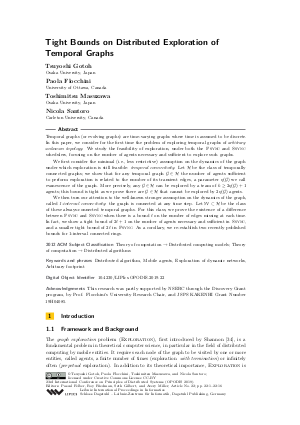@InProceedings{gotoh_et_al:LIPIcs.OPODIS.2019.22,
author = {Gotoh, Tsuyoshi and Flocchini, Paola and Masuzawa, Toshimitsu and Santoro, Nicola},
title = {{Tight Bounds on Distributed Exploration of Temporal Graphs}},
booktitle = {23rd International Conference on Principles of Distributed Systems (OPODIS 2019)},
pages = {22:1--22:16},
series = {Leibniz International Proceedings in Informatics (LIPIcs)},
ISBN = {978-3-95977-133-7},
ISSN = {1868-8969},
year = {2020},
volume = {153},
editor = {Felber, Pascal and Friedman, Roy and Gilbert, Seth and Miller, Avery},
publisher = {Schloss Dagstuhl -- Leibniz-Zentrum f{\"u}r Informatik},
address = {Dagstuhl, Germany},
URL = {https://drops.dagstuhl.de/entities/document/10.4230/LIPIcs.OPODIS.2019.22},
URN = {urn:nbn:de:0030-drops-118082},
doi = {10.4230/LIPIcs.OPODIS.2019.22},
annote = {Keywords: Distributed algorithm, Mobile agents, Exploration of dynamic networks, Arbitrary footprint}
}

 Creative Commons Attribution 3.0 Unported license
Creative Commons Attribution 3.0 Unported license



































